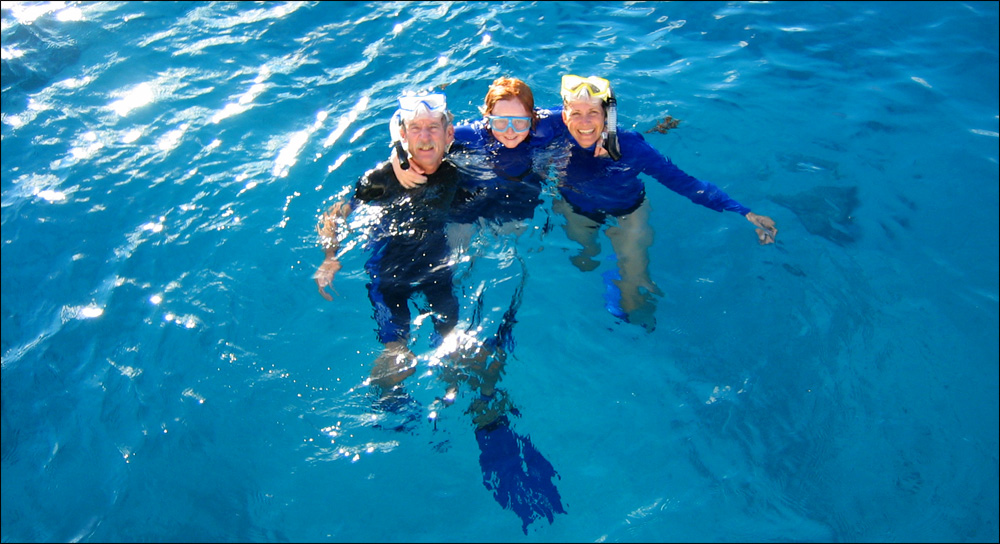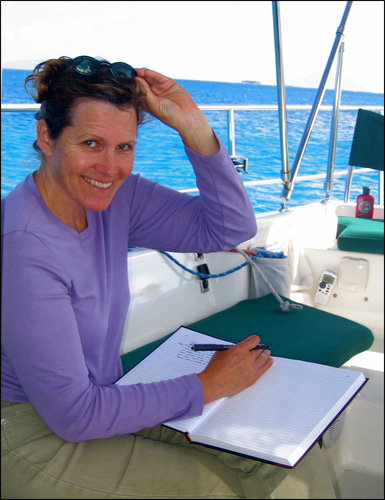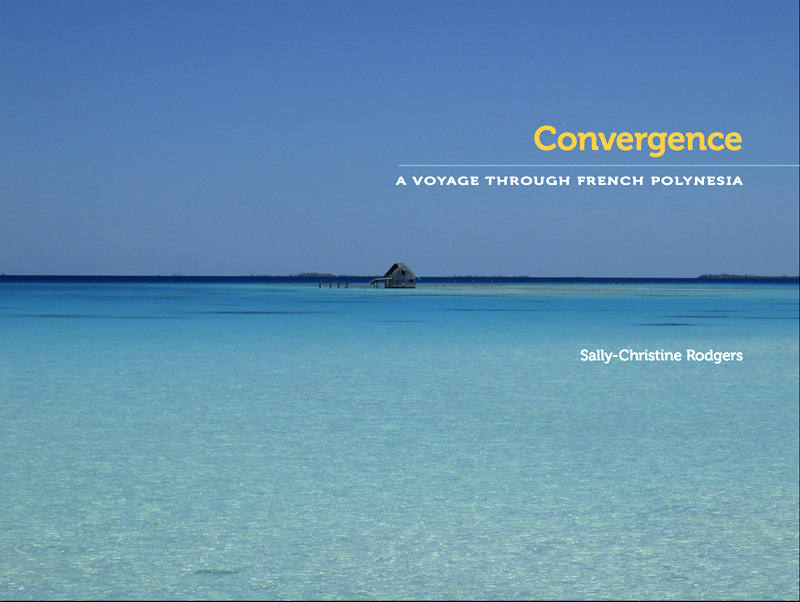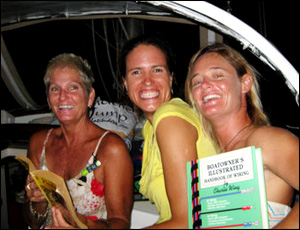Marine Conservation is my passion and I have worked on ocean issues for decades learning a great deal along the way.

Sally-Christine Rodgers with husband Randy Repass & their son, Kent-Harris.
The oceans are in crisis and we who love them need to step up and be vocal in support of sustainable seafood, reducing Co2 emissions, and limiting plastics, which have impacted the oceans so dramatically.
I also believe that women play an important role in not only educating their families, but in using their buying power and influence on others, including our government’s representatives. Buying local organic food, only eating sustainable seafood, choosing bio-degradable cleaning products, reducing waste, not drinking water from plastic bottles, informing your representative on ocean legislation and supporting marine conservation organizations are just some of the ways we can participate in the health of the oceans.
In preparing for cruising, we made a lot of decisions that we hope reduced our impact; We use Bottom shield bottom paint with less copper content when available. We are very conscious of our waste. I remove and recycle nearly all packaging materials from our larder before we leave. I then repackage foodstuffs in seal-a-meal bags, which make it much easier to store, see what you have, control portions, and the bags are re-sealable! (Not to mention everything lasts forever!)
We did not throw anything we could not eat overboard. This gets tricky on small boats, and careful planning is necessary, but it can be done. I saved all of my glass jars to give to island women who loved having them as storage containers. We also work hard to see where trash is disposed. Often in small communities, it is just dumped or burned. Recycling is not common.
Cleaning products are often toxic. Why use them? Vinegar and Baking Soda work very well in most instances. A couple of other examples include using Cream of Tartar and hot water for cleaning Aluminum. Hydrogen Peroxide can be used instead of Bleach. Apple cider vinegar and baby oil is a good polish for chrome and stainless. And there are many biodegradable cleaning products available. (Pure Oceans Products at West Marine for example.) I stock up as they are hard to find once you leave.
We also actively organized beach cleanups with other cruisers.
It is all about making choices. Frankly most cruisers use few resources, they are careful with water and power, and live simply. That is what most cruisers want really, to simplify our lives, get close to our spouses and children and to truly be ourselves in nature.
I would love to see Women and Cruising hold a forum on what cruising women have learned about cruising sustainably. I am certain there is much we can learn from each other, and in supporting each other we can have an impact on the health and protection of the oceans.
Sally-Christine’s thoughts on Marine Conservation
Excerpt from her book
“Convergence – A Voyage Through French Polynesia”When I was a child, the sea seemed vast and abundant. But today, the oceans of my childhood no longer exist. I am not a scientist, but I am an observer, and sailing long distances has given me an acute awareness of the negative impact that human behavior has had on our oceans. In my lifetime, I have witnessed startling changes in water temperature and the rapid decrease in the quantity and diversity of marine life. Pollution is ubiquitous, and critical habitats such as coral reefs are being adversely affected, in some cases beyond the point of recovery.
Pollution
Agricultural runoff, mining, aquaculture (e.g. farmed salmon), unrestricted coastal development, and unregulated manufacturing practices are just some sources of pollution that threaten the health of the oceans and contaminate the food we eat from the sea.
Nutrient-rich fertilizers discharged in agricultural run-off are causing dead zones—low oxygen (hypoxic) areas in the ocean where life simply cannot survive—causing entire ecosystems to collapse. Mercury and other heavy metals from power plants, pesticides, herbicides, detergents, sewage, oil, and plastic are also ending up in our oceans. Even residue from the pharmaceuticals we ingest is found in the fish we eat. A United Nations Environment Program study estimated that every square mile of ocean contains 46,000 pieces of floating plastic. I have been thousands of miles away from land and have seen the floating debris.
More than a million seabirds and hundreds of thousands of marine mammals die from ingesting photodegraded micro-plastics, which are now part of the food chain. A study from the Scripps Institution of Oceanography estimated that fish in the intermediate ocean depth of the North Pacific ingest roughly 12,000 to 24,000 tons of plastic per year. Do you know what happens to your discarded plastic waste?
Overfishing
Although some fisheries are successfully managed, overfishing and unsustainable fishing practices are taking a catastrophic toll on world fisheries. Industrial fishing methods, such as bottom trawling, destroy critical habitats by dragging chains and nets over the sea floor, essentially wiping out entire ecosystems.
It is estimated that industrial fishing fleets discard 27 million tons of non-targeted fish and other sea life every year. In some fisheries, up to ten pounds of life is discarded for every pound of seafood that makes it to market. This intolerable waste is known as by-catch. Undersized fish, turtles, dolphins, whales, and sharks are just some of the species being discarded, dead or dying, with each haul. Seabirds are also affected. According to Carl Safina of Blue Ocean Institute, an estimated hundred thousand albatross are killed annually by longliners alone.
Over 90 percent of the seafood brought to market in the U.S. is imported. According to a Natural Resources Defense Council report, nearly every foreign fish product sold in the U.S. has been caught in a way that violates U.S. federal marine mammal protection laws. It is worth thinking about where your seafood comes from and supporting sustainable American fisheries.
Ocean Acidification
There is no longer any doubt that climate change is playing a role in our rapidly changing world. It has been scientifically documented that increases in temperature from natural weather fluctuations exacerbated by industrialized increase of CO2 emissions are leading to potentially catastrophic depletion of marine life.
CO2 is absorbed in the ocean as a natural process, but increased levels of CO2 reduce calcium carbonate; the sea becomes acidic and less hospitable to life. Over time, the reduction in calcium carbonate prevents creatures like shellfish—oysters, mussels, crab, and shrimp—from forming shells. In fact, existing shells start to dissolve. Coral reefs, home to the greatest biodiversity of ocean life, die. The smallest ocean animals at the base of the ocean food web, including zooplankton, cannot survive in these acidic conditions. And if zooplankton cannot survive, sea life further up the food chain—fish, mammals, and seabirds—will also perish. No food, no life! One billion people rely on seafood for their primary source of protein. The implications are obvious.
What Can One Person Do?
Humanity as a whole may be responsible for the degradation of our oceans, but I believe that we are all capable as individuals of responding to this crisis. How? Each one of us can make lifestyle choices that reduce our carbon footprint, reduce our own contribution to pollution, and educate our children.
Here are some thoughts on ways to begin:
Vote With Your Dollars
• Stop buying water in plastic bottles.
• Don’t use plastic bags.
• Don’t use Styrofoam or polystyrene products.
• Eat only sustainable seafood and support sustainable fisheries.
• Eliminate toxic chemicals from your homes; encourage your workplace to do the same.
• Avoid non-organic fertilizers and pesticides.
• Buy local, organic produce and products.
• Review your transportation options.Finally, and very significantly, we can all get involved, becoming educated—and passionate—advocates for our oceans, the life-support system of our planet.
Be aware of your own carbon emissions and share your knowledge with others.
Contact and support marine conservation efforts locally and nationally. Following is just a partial list of organizations that I respect.
- Blue Ocean Institute
Led by Dr. Carl Safina, the institute works to create a more knowledgeable constituency for conservation.- Ocean Champions
A 501(c)(4) with an attached political action committee (PAC), this is the first-ever political advocacy organization dedicated to protecting the ocean and its wildlife. Ocean Champions is focused on building support for ocean conservation in the U.S. Congress.- Oceana
This is the largest conservation organization focused solely on the oceans. It uses scientists, economists, lawyers, and advocates to achieve tangible results.- Ocean Conservancy
“Informed by science, our work guides policy and engages people in protecting the ocean and its wildlife for future generations.”- Monterey Bay Aquarium Seafood Watch
The Aquarium’s Seafood Watch Program helps sustain wild, diverse, and healthy ocean ecosystems by encouraging consumers and businesses to purchase seafood that is fished or farmed in ways that don’t harm the environment.
About Sally-Christine Rodgers

Sally-Christine Rodgers grew up as one of a “water tribe;” has lived near the water and worked in the marine industry all of her life.
Her passion for the oceans and her desire to raise awareness of their plight led Rodgers to support conservation efforts across the country and around the world. Rodgers and her husband jointly endowed a Duke University Professorship in Conservation Technology and a Platinum Leeds building dedicated to Marine Conservation Education at the Duke Marine Lab in Beaufort, NC.
She has raced in the Vic Maui and Pacific Cup Races to Hawaii, and sailed with her husband and son across the South Pacific, South East Asia and in many parts of Europe.
When not on the water, Rodgers has her hands in the earth, tending vineyards, keeping bees, and raising longhorns on the California coast.
Convergence: A Voyage Through French Polynesia
by Sally-Christine Rodgers
Convergence: A Voyage through French Polynesia is a personal story of one woman’s adventure – her lifelong passion for the ocean, and her struggle to face her fears as she learns to surrender to nature.
Along the way, she comes to realize that passages are not just about getting from one place to another. Journeys like this one go to the heart of who you are when you start out and who you have become when you get to the other end.
www.convergencevoyages.com
PROCEEDS DONATED TO MARINE CONSERVATION
Available for purchase at West Marine and westmarine.com
More from this website
-
Cruising on Convergence : Building the boat, by Sally-Christine Rodgers
-
When green meets blue: Katharine Lowrie, aboard Listalight, discusses what we can do to sustain as blue-green a life as possible.
Women and Cruising would like to hear from other women on ways that we can care for our oceans as we cruise, support marine conservation, and raise awareness of environmental issues.
The Sailing Green posts on Women and Cruising can become a way to share these ideas.


